Municipal Engineering
now browsing by category
Carl E. Peters Receives NJ Municipal Engineers Award
On Wednesday, November 16, 2016, Carl E. Peters, P.E., P.L.S, P.P, C.O received the New Jersey Society of Municipal Engineers (NJSME) award for distinguished service, Todd Hay, P.E., President of NJSME, presented the recognition at the society’s annual luncheon at the New Jersey State League of Municipalities Conference in Atlantic City.

NJ Society of Municipal Engineers Awards luncheon November 2016. Pictured from left are Kimberli Craft, PE, Carl Peters, PE, PLS and Todd Hay, PE
Peters, who is Past President of the statewide municipal engineering group, was honored for his: “Outstanding contribution as author of the NJSME ‘Analysis of NJ’s Municipal Road Repair Needs’ … and publishing the report as the State addressed TTF (Transportation Trust Fund) reform”.
He is pictured at left with 2016 NJSME President Todd Hay, PE and incoming president Kimberli Craft, PE.
Peters, who was the NJSME president in 2007, was the Municipal Engineer for the former Borough of Princeton from 1984 – 2007. He has remained active with the New Jersey Society of Municipal Engineers since leaving public employment. He has served on both the Executive Committee and Advisory Board and is also an instructor in the society’s Certified Municipal Engineer (CME) program.
Peters provides training to professional engineers about New Jersey’s Municipal Land Use and Construction Code regulations. His class is part of a ten day program of courses developed by NJSME. The program’s mission is to educate engineers about the broad range of topics required to practice as a municipal engineer.
Peters is currently in private practice with an office in Fords, NJ. He provides consulting services in the areas of land use, construction code analysis, handicapped (ADA) access and litigation support.
“Local Street Repair Cost” Paper at 2017 TRB Meeting
Peters, Peters and Gordon to present paper at TRB
Carl E. Peters, P.E., and co-authors Jonathan R. Peters, Ph.D. and Cameron Gordon, Ph.D. will be presenting their paper “Who should pay for the local street? Who does? A survey of New Jersey municipalities” at the annual meeting of the Transportation Research Board in Washington, DC, in January 2017.
About TRB
According to its website, The Transportation Research Board (TRB) “is one of seven program units of the National Academies of Sciences, Engineering, and Medicine, which provides independent, objective analysis and advice to the nation and conducts other activities to solve complex problems and inform public policy decisions.”The mission of the Transportation Research Board (TRB) is to promote innovation and progress in transportation through research.”
How Much Does It Cost to Maintain New Jersey’s Local Streets?
The paper, which is based upon a study the team performed for the New Jersey Society of Municipal Engineers, quantifies the cost to keep New Jersey’s local streets in good repair. The report establishes the cost to maintain an average mile of a local street in New Jersey for a sixty year life span, It then projects the annual repair repair cost for all municipally maintained roads by multiplying the cost per mile by the total length of streets in municipal jurisdiction. The resulting annual need is a staggering $1.2 billion.
How is Transportation Funded in New Jersey?
The paper includes an analysis of the current revenue sources available for the upkeep of municipal streets, along with State and County roadways and New Jersey Transit.
The New Jersey Department of Transportation (NJDOT) 2010 listing of roadway mileage by jurisdiction shows that approximately 29,000 of the state’s 39,000 miles of roadway’s are maintained by municipalities. In 2014, State and Federal Aid to municipalities for local street repairs was less than $100 million. The remaining revenues to fix local streets must come from municipal budget sources, primarily property taxes.
Are Current Funding Methods Fair?
The paper raises the question “Who benefits from local streets?” as well as “Do all of the parties that benefit from local streets pay their fair share of maintenance costs?”
Only about 3% of New Jersey’s Transportation funding from state and federal sources is distributed to municipal governments.(see graph below for the period 2006 -2016),
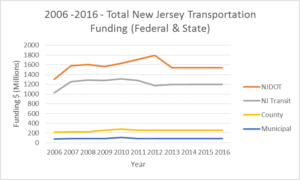
NJ Transportation Funding 2006 -2016
New Jersey Department of Transportation records indicate that in 2014 approximately 15% of average daily traffic was carried by local streets.
The network of New Jersey’s municipal roads is extensive. Most vehicular trips have either an origin or destination on a local street. Local streets serve emergency services, commerce and other regional travel. Municipalities must maintain over 70% of New Jersey’s road mileage. These local streets carry over 15% of the vehicular trips per day. While noting that State and County roads are generally wider and carry larger volumes of truck traffic, it appears that New Jersey’s municipalities are being shortchanged when it comes to the distribution of funds for transportation.
What does the future hold for funding of local street repairs?
This paper has identified that we have much work to do to address efficient funding for local streets, sidewalks and curbs in particular. It is clear that the deferred maintenance and ongoing investment challenges are extensive and that the funding gap is massive. Yet these needs are largely ignored on the state and federal level; thus these costs and problems are left to the local governments. Like many state and federal unfunded mandates, the local governments then have to struggle to find funding sources to address problems that are not always just local in scope.
NJ Municipal Road Repairs – Where’s the Money?
Municipal road repair needs are staggering
New Jersey’s municipalities need help. They’re in need of an adequate, steady source of funding for their road repairs. A recent report prepared for the New Jersey Society of Municipal Engineers estimates the annual need for municipal road repairs at almost $1.3 billion. New Jersey’s municipalities, who are constrained by a 2% tax cap, cannot adequately maintain their streets without both more funding from the Transportation Trust Fund (TTF) and a more equitable way of sharing those revenues with the counties.
On June 23, 2016 committees of both the New Jersey Senate and Assembly approved bills to provide new revenues for the New Jersey Transportation Trust Fund which supports Department of Transportation (NJDOT), New Jersey Transit (NJT) and County and Municipal road, bridge and mass transportation projects. Providing the capital to maintain the state’s transportation infrastructure is vital to New Jersey’s economic health
Local Aid to Municipalities is Meager
Unfortunately for Municipalities, they are at the end of the line when it comes to distribution of revenues from the Transportation Trust Fund. For the past ten years New Jersey Municipalities have received only about 3% of the state’s transportation funding (see graph below).
This fact is especially troubling to local Mayors, Administrators and Engineers who are responsible for the maintenance of New Jersey’s more than 29,000 miles of municipal roadways representing 75% of the centerline road miles in the entire state.
New Jersey’s Centerline Miles of Roads based upon 2010 NJDOT Inventory
- NJDOT 2,323 = 6%
- Authority 411 = 1%
- County 6,449 = 17%
- Municipal 29,408 = 75%
- Park 649 = 2%
- Total 39,241 = 100%
Local Roads don’t get enough funding from the Transportation Trust Fund
Local roads (county and municipal) carry over 50% of the traffic in New Jersey every day. Presumably, at least 50% of the fuel consumed in New Jersey is used while driving on local roads. Thus 50% of the fuel taxes are generated by vehicles travelling on local roads. Why isn’t 50% of the fuel tax revenue distributed to municipal and county governments to maintain their respective portions of New Jersey’s transportation network. Unfortunately, Governor Christie doesn’t believe that municipal and county governments are deserving of a share of the fuel taxes collected.
State and Federal Aid to Municipalities and Counties
Since 2009, annual allocations of $78.75 million each have been made for County and Municipal road repairs. The counties have also received $25 million annually for bridge maintenance (a task that is predominantly a county responsibility). Counties also get a much larger share of federal aid – $140 million annually, while municipalities get only $10 million annually.
Unfortunately for municipal governments, this cost sharing formula does not reflect the actual cost to maintain New Jersey’s Municipal Road network. Ideally, municipal and county governments should receive sufficient state and federal funding so that the portion of road repair costs financed through property taxes is similar.
Property Tax Distribution Rates
The New Jersey Department of Community Affairs reports that the state’s 2015 property taxes were distributed as follows:
- School Taxes 52.3%
- County Taxes 18.1%
- Municipal Taxes 29.6%
While the ratio of Municipal to County Road Mileage is 4.56 to 1, the ratio of Municipal to County tax levies is only 1.64 to 1.
Potential Cost Sharing Alternatives
Cost Split based upon Road Mileage
One option would be to apportion TTF local aid revenues between counties and municipalities based upon the length of roads within each jurisdiction, or:
- 81% for municipalities
- 19% for counties.
County Freeholders, Engineers and Executives would likely argue that such an allocation of funds was unfair – since county roadways are often wider and carry greater daily traffic volumes than do municipal streets. Such factors increase construction costs and the needed frequency of road repairs.
Cost Sharing Considering Traffic Volumes and Weighted Road Mileage
It may, therefore, be fairer to establish a method of sharing local aid that considers traffic loads as well as roadway length and also gives county roads a mileage bonus to account for their greater average width.
In this alternative, each of these two components for the sharing of local aid – Traffic and Weighted Mileage is used to allocate one half of the local aid funds.
Traffic Sharing Factor
- 50% County, and
- 50% Municipal
Weighted Mileage Sharing Factors (Using an allowance for the average county road being 40′ wide versus 30′ average width for municipal roads)
- Municipal Mileage Factor (MMF) = Municipal Miles/(1.33*County Miles + Municipal Miles) = 29,408/37,985 = 77%
- County Mileage Sharing Factor (CMF) = 1.33*County Miles/(1.33*County Miles + Municipal Miles) = 8,577/37,985 = 23%
Local Aid Sharing Formula based upon both Traffic and road inventory
- County Share = (Traffic + CMF)/2 = (50% + 23%)/2 = 36.5%
- Municipal Share = (Traffic + MMF)/2 = (50% + 77%)/2 = 63.5%
This proposal would:
- Provide immediate property tax relief,
- Help to support adequate municipal road repairs, and
- Distribute fuel tax revenues evenly over roads that were used to generate them.
What do you think?
Sidewalk Repairs in New Jersey – Who gets the bill?
Sidewalk Repairs are in the news.
Sidewalks, or more specifically defective sidewalks, have been in the news in New Jersey lately — raising the issues of “What rules dictate where sidewalks are installed, who is responsible for making sidewalk repairs and how do New Jersey municipalities and property owners share the cost of sidewalk repairs?”
Towns making news about sidewalk repairs
In its July 22, 2012 article “Amid slippery laws, towns take a stand on sidewalk repairs”, the Star Ledger reported about a program in Highland Park, NJ to require homeowners to repair defective walkways in front of their lots. Judging by the comments on NJ.com, the residents are incensed about being required to fix defective sidewalks.
Scott Luthman, Highland Parks’s Construction Official, advised that approximately 1200 notices have been issued to repair cracked, settled, heaved or otherwise deteriorated sidewalks throughout the 1.9 square mile borough. This initiative was sparked by complaints from local residents, many of whom walk to worship services. According to Mr. Luthman, Highland Park offers to contract for the repairs and to bill the property owner for the actual costs incurred by the borough. Payments may be made over a five year period with a modest rate of interest applied to the bill. Commercial and residential property owners are treated alike. If the property owner chooses to select a contractor, the borough will provide a tree expert to alter street trees that are raising sidewalk slabs. So far, most residents are quietly conforming to the policy – there are, however about 15 to 20 property owners that are very unhappy and vocal.
A similar tale is unfolding in Ridgewood where the Village has issued 160 notices to residents requiring them to repair sidewalks within 45 days. Much of the damage in Ridgewood is caused by trees planted in the grass strip between the curb and sidewalk. The property owners are being held accountable for repairing the sidewalks despite the fact that neither the trees or the sidewalk are on their property. Waldwick allows residents until the end of the year to make repairs and will consider giving extensions of time due to financial hardship.
How some other municipalities approach sidewalk repair financing.
Having been the Municipal Engineer for the Borough of Princeton for over twenty years, I understand the intensity of feeling often generated by requests of the municipality to have sidewalks repaired – or even worse installed where none existed before. The Princeton Borough Code also requires adjacent property owners to construct and maintain the sidewalks within the public right of way in front of their premises — including the removal of snow and ice.
In the mid 1980’s, the Borough of Princeton developed a program that required the evaluation of all sidewalks within the limits of road construction and overlay projects. Repair of defective sidewalks was included in the scope of the borough’s capital projects. Property owners that elected to have their sidewalks replaced by the municipal contractor were assessed at 50% of the cost of the improvement, payable over a 5 – 10 year period. Persons opting to perform the work on their own were not offered a subsidy.
Princeton Borough Engineer, Jack West reports that his office is currently administering an annual sidewalk repair program valued at over $120,000. This year’s program is primarily for the repair of walks damaged by municipal shade trees, These repairs are made at no cost to the adjacent property owner. Mr. West noted that the municipal ordinance allows his office to issue violation notices to property owners but only does so if a complaint initiated investigation reveals that the condition is very unsafe. Otherwise, repairs are made in conjunction with the borough’s capital road improvement program.
Princeton Township Engineer, Robert Kiser reported a similar policy of assessing homeowners for 50% of sidewalk repair costs as part of a capital road project. The township does not assume the entire cost for repair of walks disturbed by street trees but does bear the cost of handicap accessibility improvements such as curb ramps and detectable warning strips.
In nearby Lawrence Township, Municipal Engineer, James Parvese reported that property owners are given the opportunity to have their sidewalks replaced as part of a municipal project and make payments over time but are billed for 100% of the repair cost.
According to Robert Vogel, Municipal Engineer, Madison Borough maintains the sidewalks in the Central Business District through a maintenance agreement with the New Jersey Department of Transportation for the sidewalk area on Route 124. Generally, Madison holds property owners responsible for sidewalk repairs but provides a 25% incentive when the work is performed as part of a municipal project, which they run every year. There is no charge for damage caused by a municipal shade tree or improvements made to remove barriers for the disabled.
Freehold Township takes yet another approach. Township Engineer, Tim White outlined a novel incentive program which allows homeowners – not commercial properties – to request a 50% rebate from the township for sidewalk repairs they have performed by a contractor. Under this program, property owners must make application to the township prior to starting the work. The Township Engineer then inspects the property to determine if the repairs are necessary and that the damage has not been caused by the property owner’s negligence (such as allowing heavy equipment to pass over the sidewalk). To qualify for the reimbursement, the property owner must obtain a road opening permit, post a bond, have the work inspected and provide copies of the concrete delivery ticket and the contractor’s invoice. The town will then provide a 50% reimbursement up to a cost of $7/ sf for 4” thick walk and $9 / sf for 6” thick walk. Currently, an annual budget of approximately $25,000 is provided for this program.
“Home Rule” prevails – one size doesn’t fit all in New Jersey.
Policies in other municipalities range from: requiring property owners to make repairs based upon the results of housing or continued certificate of occupancy inspections to just not doing anything about sidewalks because they are the property owners problem. The most prevalent policy seems to be to direct the property owner to make the repair or have the municipality contract for the work and assess the owner for 100% of the cost.
I’d like to know how this problem is addressed in your community. Please leave a comment.
Of course this is just the opening salvo in a discussion about sidewalks in New Jersey. In the near future I plan to discuss matters such as:
- How did sidewalk installation and maintenance policies evolve in New Jersey?
- What regulations define where sidewalks are to be built and the standards of construction.
- Who’s liable for an injury occurring on the sidewalk in front of your property? – Does the answer to this question change if the property is residential, commercial, or non-profit?
- Do the sidewalk requirements in the NJ Residential Site Improvement Standards (RSIS) conform to those in the Public Rights of Way Accessibility Guidelines (PROWAG)?
- Will municipalities eliminate sidewalk repair subsidies in response to the 2% State mandated budget caps?
And, a bit more.
I’d like to know how this problem is addressed in your community. Please leave a comment.
[poll id=”6″]
The author, Carl E. Peters is one of fewer than 10 people licensed by the State of New Jersey as a Professional Engineer, Professional Land Surveyor, Professional Planner, Construction Official, Building Subcode Official and Plumbing Subcode Official. He is also a Certified Municipal Engineer and Mediator and founder of Carl E. Peters, LLC
What if you built a marina and nobody came? or New Brunswick Landing
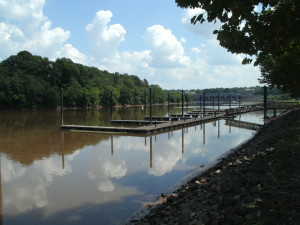 A few weeks ago I read an article in the Star Ledger about some new docks that have been constructed on the Raritan River in New Brunswick by Middlesex County in partnership with the City of New Brunswick. Apparently they spent $7 million of tax money obtained through Green Acres grants. to construct 12 slips capable of accommodating boats of up to 45′ in length.
A few weeks ago I read an article in the Star Ledger about some new docks that have been constructed on the Raritan River in New Brunswick by Middlesex County in partnership with the City of New Brunswick. Apparently they spent $7 million of tax money obtained through Green Acres grants. to construct 12 slips capable of accommodating boats of up to 45′ in length.
You can see the whole story at:
http://www.nj.com/news/index.ssf/2012/06/new_floating_dock_makes_a_spla.html
Having spent many hours on the Raritan River between Piscataway and Sayreville during my rowing days at Rutgers, my first thought was “There’s no water there at low tide.” My second thought was that it seems like an awfully long and winding trip from the mouth of the Raritan River to New Brunswick (but I’m generally in vessels powered either by sails or oars so maybe power boaters would view the situation differently).
I was in New Brunswick last Thursday for a business meeting and saw a variable message board on Route 18 announcing that the docks at Boyd Park were open for use – I had to check it out. What I found were some very attractive floating boat slips located just downstream of the Albany Street Bridge. I noticed that there was an additional channel marker near the docks. Previously, the channel had ended a few hundred yards downstream near the entrance to the Delaware and Raritan Canal.
On the date of my visit the tide was not quite low. The river bed was exposed at places upstream of the dock so it appears that it would be unwise to venture beyond the limits of New Brunswick Landing. There were no boats in the slips last Thursday afternoon but there was a county employee on site to perform maintenance and to register guests to the facility. He advised me that there were originally more berths at the site but some were damaged during Hurricane Irene in August 2011. He said that there was no charge for docking privileges and that boats were permitted to stay overnight but that the gates to the dock would be locked after hours.
I left feeling that the facility was very attractive and appeared well engineered but still wondering “Who is going to use this dock” and “Was this a wise use of $7 million of public funds?” In my mind if the facility is well used then the investment in the New Brunswick waterfront is a good one. What I’d like to know is if you boaters out there plan to take the trip to New Brunswick and tie up at New Brunswick Landing.
[poll id=”5″]
The author, Carl E. Peters is one of fewer than 10 people licensed by the State of New Jersey as a Professional Engineer, Professional Land Surveyor, Professional Planner, Construction Official, Building Subcode Official and Plumbing Subcode Official. He is also a Certified Municipal Engineer and Mediator and founder of Carl E. Peters, LLC



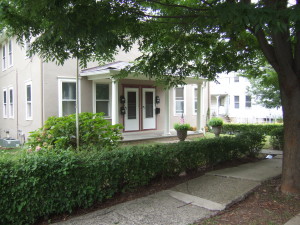
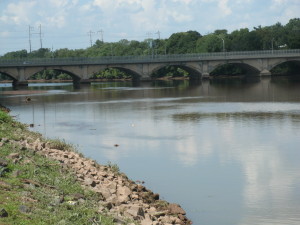
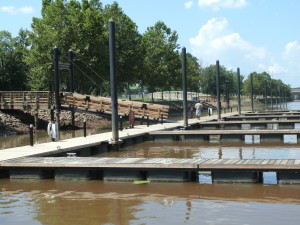
 D5 Creation
D5 Creation